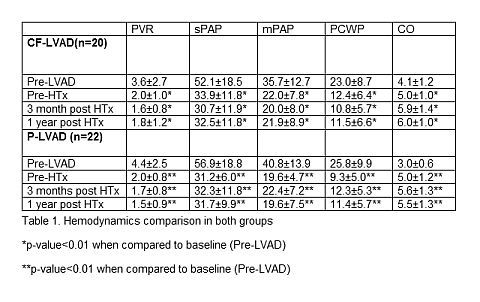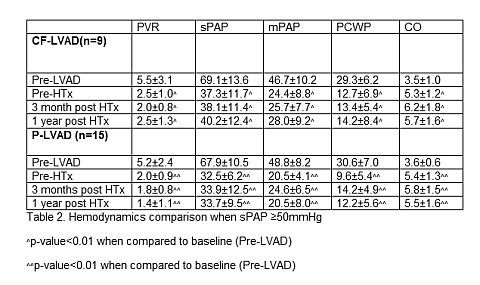Pulmonary Vascular Hemodynamics Improvement with Left Ventricular Assist Devices Unloading Is Sustained after Heart Transplantation
UTAH Cardiac Transplant Program, Salt Lake City, UT
Meeting: 2013 American Transplant Congress
Abstract number: C1449
Background:
Pulmonary hypertension (PHT) is frequently seen in patients with advanced heart failure (HF) awaiting heart transplantation (HTx). Severe PHT is a contraindication for HTx. Both Pulsatile (LVAD) and Continuous Flow (CF-LVAD) Left Ventricular Assist Devices have been shown to improve pulmonary hemodynamics (PHD) and thus impact patients’ eligibility for HTx. However, whether the improvement in PHD is sustained after HTx is not well defined.
Methods:
The UTAH Cardiac Transplant Program database was queried for stage D HF patients with PHT who received either a P-LVAD or CF-LVAD as a bridge to HTx between 2001 and 2011. PHD were evaluated by right heart catheterization at different time points: before LVAD placement, prior to HTx, at 3 and 12 months after HTx. These parameters were compared between different time points and between different types of LVADs.
Results:
Forty two patients (age 52±10, 85% males) were included in the study. Twenty patients received CF-LVAD and 22 patients had P-LVAD. After LVAD unloading, LV filling pressures significantly decreased, which in turn resulted in lower pulmonary artery pressures and vascular resistance. The beneficial effect of LVAD unloading was sustained through the first 12 months after HTx. There were no significant differences in PHD at any time point between both types of LVADs (table1). These results were similar for a subgroup analysis including patients with pulmonary artery systolic pressure ≥ 50 mmHg (table 2).


Conclusions:
LV unloading with either CF-LVAD or P-LVAD significantly improved PHD in HTx candidates with different PHT severity. These favorable changes were sustained up to 12 months after HTx in both groups.
To cite this abstract in AMA style:
Saidi A, Wever-Pinzon O, Stehlik J, Gilbert E, Alharethi R, Selzman C, Reid B, Budge D, Kfoury A, Bader F. Pulmonary Vascular Hemodynamics Improvement with Left Ventricular Assist Devices Unloading Is Sustained after Heart Transplantation [abstract]. Am J Transplant. 2013; 13 (suppl 5). https://atcmeetingabstracts.com/abstract/pulmonary-vascular-hemodynamics-improvement-with-left-ventricular-assist-devices-unloading-is-sustained-after-heart-transplantation/. Accessed December 9, 2025.« Back to 2013 American Transplant Congress
